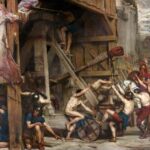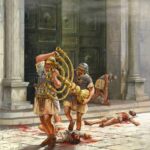In the south of Portugal, near the town of Vidigueira, there are remains of a large Roman villa, which dates back to the first century CE. Scientists were able to determine three separate phases of the existence of the building that was being rebuilt.
As mentioned, the first structure was built in the middle of the first century CE. However, it was destroyed and in the middle of the second century CE a new villa was established. This, in turn, declined, and therefore at the end of the second century CE the third version of the villa was created, which ruins can be admired to this day. Of the first two phases, only wall fragments have survived. In the 4th century CE the villa was inhabited by the bishop, and the preserved parts of previous villas were joined together.
Entering the archaeological park, the first thing that will appear to our eyes will be the isolated ruins of the temple, which was dedicated to an unknown Roman deity. In the 5th century CE the building was converted into Christian purposes – burials were found in the portico.
At the front of the villa was a garden, which gradually expanded along a large water reservoir that could serve as a swimming pool in summer. From the pool side there was a terrace with a gallery, where the hosts welcomed their guests. On the other side of the building there was another water pool.
The villa had two levels. At the bottom were, among others pantry and triclinium. The building also had thermae that were adapted for the bishop’s villa. A narrow and steep staircase led upstairs, where in turn there was a longitudinal porch along the entire length of the building and numerous rooms.
The bishop’s villa also had a separate rural part, where slaves or employees lived. There was also press for grapes or olives (lagar).
The villa was abandoned in the middle of the 5th century CE.
Discovered artifacts are kept in the town hall of Vidigueira.
- Commagene – a betrayed ally
- A pagan temple in Sao Cucufate
- A pagan temple in Sao Cucufate
- Horse skeleton on display in Pompeii
- Front of the Bishop’s Villa in Sao Cucufate facing the great pool
- Terrace of a villa in Sao Cucufate
- Pool behind the villa in Sao Cucufate
- Didyma – Temple of Apollo
- Didyma – Temple of Apollo
- Didyma – Temple of Apollo
- Didyma – Temple of Apollo
- Didyma – Temple of Apollo
- Didyma – Temple of Apollo
- View from the upper floor of the remnants of the Sao Cucufate thermal baths
- Commagene – a betrayed ally
- Remains of villa rustica buildings in Sao Cucufate























